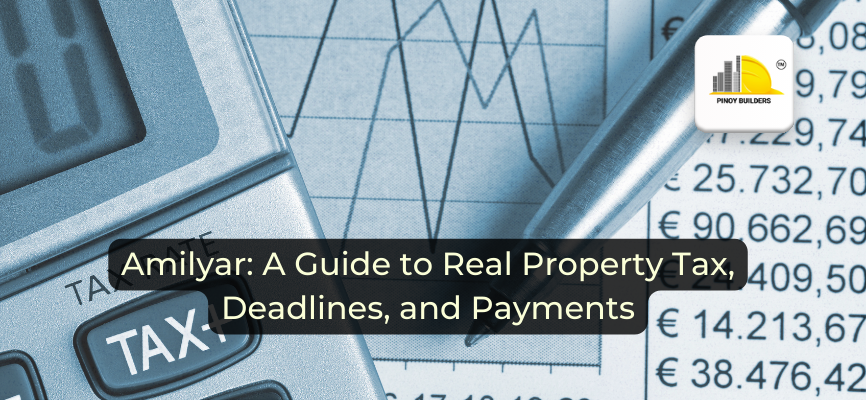Owning a home is one of the biggest accomplishments a Filipino could have. Having your own house will offer your family safety and security. However, owning a home comes with the responsibility of the government by paying the amilyar tax yearly.
While the amilyar is an important tax, many Filipinos have a limited understanding of it. In this article, we will discuss what amilyar is, why you should pay, how to compute it, and how to pay it.
What is an Amilyar?
Amilyar or Real Property Tax (RPT) is a tax real property owners must pay annually. The word amilyar is derived from the Spanish word amillaramiento, which means assessment of a tax. During the Spanish colonization, the datus who ruled their barangays collected this tax for security.

In modern times, the amilyar is imposed by the Local Government Unit (LGU) where your real property is located under sections 197 to 283 of the Local Government Code. According to Article 415 of the Civil Code, real property or immovable property covers land, buildings, roads, and constructions of all kinds adhered to soil, trees, plants, growing fruits, statues, machinery, and many other things attached to the land.
Failure to pay the amilyar will result in the auction of your property.
When is the Deadline for Amilyar?
Real property owners must pay their amilyars on or before January 31 of every year. However, there is an option to pay your amilyar in four (4) installments if you cannot settle the tax in full. Here are due dates of each installment:
- 1st Quarter: On or before March 31
- 2nd Quarter: On or before June 30
- 3rd Quarter: On or before September 30
- 4th Quarter: On or before December 31
Failure to pay on time will result in 2% of the unpaid amilyar amount per month with a maximum of 72% for 3 years (36 months). After 3 years, the LGU may auction your property.
How much is Amilyar in the Philippines?
To compute the amount of amilyar, you would need to follow this formula: Real Property Tax = Rate x Assessed Value. Your tax rate would depend if your property is in or outside Metro Manila.
- If your property is inside Metro Manila, your amilyar is worth 2% of your property’s assessed value. For example:
- If your property’s assessed value is P3,000,000.00, your amilyar would be: P3,000,000.00 x 2% = P60,000.00.
- If your property is outside Metro Manila, you would only need to pay 1% of your real property’s assessed value as your amilyar. For example:
- If your property’s assessed value is P10,000,000, your amilyar would be: P3,000,000 x 1% = P30,000.
Did you know that you can have a discount when paying your amilyar? Most LGUs offer a 5%-20% discount for taxpayers who pay early or make advanced payments. Not only will enjoy a discount, but you will also avoid long queues and delinquencies.

How to Pay Your Amilyar?
There are two ways you can use to pay your amilyar: in-person and online.
To pay in person, you can visit your LGU’s Treasurer’s Office or through their designated centers. Here’s a step-by-step process on how you can make your payments through the aforementioned channels:
- If you’ve already paid before, prepare the following documents: previous Official Receipt of Tax Payment, Property Title, and Tax Declaration Number. If it’s your first payment, bring with you a copy of your tax declaration number and property title.
- Proceed to your LGU’s designated payer’s lounge or window to assess the total amount of the tax you will pay.
- After determining the exact amount, proceed to the billing section and pay your due amount.
- Get the receipt as proof of payment.
While not available nationwide, different cities in Metro Manila support online payments. The process differs per city, but each has its designated website for the payment. It would be best to check with your LGU and ask for the online payment process.

While one of the most important taxes in the country, there is a gap in understanding what an amilyar is. Using this article as a guide, you will have an idea what it is, when are the deadlines, how to calculate your amilyar, and how to pay.
Do you want to see more content like this in the future? Subscribe to Pinoy Builders for FREE today and stay in the loop for the latest news and updates on the Philippine construction industry!
References:
- Official Gazette. (n.d.). THE LOCAL GOVERNMENT CODE OF THE PHILIPPINES. Retrieved February 14, 2022, from https://www.officialgazette.gov.ph/downloads/1991/10oct/19911010-RA-7160-CCA.pdf
- Isla, R. (2022, December 15). Real Property Tax in the Philippines: Deadlines, Discounts, Payments. https://www.moneymax.ph/government-services/articles/real-property-tax
- BOOK II (FULL TEXT) : CIVIL CODE OF THE PHILIPPINES : CHAN ROBLES VIRTUAL LAW LIBRARY. (n.d.). https://chanrobles.com/civilcodeofthephilippinesbook2.htm










